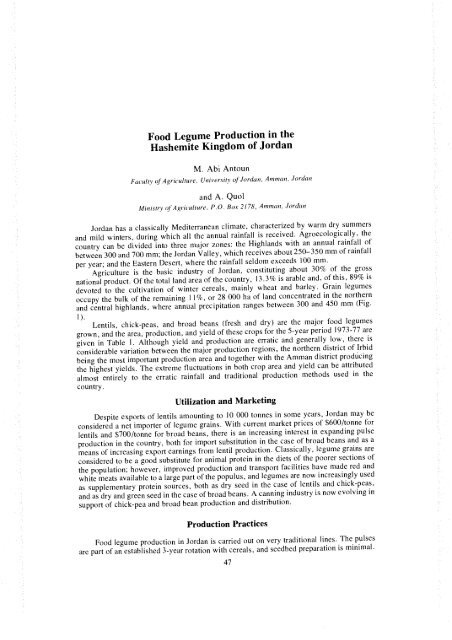I ARCHIV - International Development Research Centre
I ARCHIV - International Development Research Centre
I ARCHIV - International Development Research Centre
- No tags were found...
Create successful ePaper yourself
Turn your PDF publications into a flip-book with our unique Google optimized e-Paper software.
Food Legume Production in the<br />
Hashemite Kingdom of Jordan<br />
M. Abi Antoun<br />
Faculty of Agriculture University of Jordan, Amman, Jordan<br />
and A. Quol<br />
Ministry of Agriculture P.O. Box 2/78, Amman, Jordan<br />
Jordan has a classically Mediterranean climate, characterized by warm dry summers<br />
and mild winters, during which all the annual rainfall is received. Agroecologically, the<br />
country can be divided into three major zones: the Highlands with an annual rainfall of<br />
between 300 and 700 mm; the Jordan Valley, which receives about 250-350 mm of rainfall<br />
per year; and the Eastern Desert, where the rainfall seldom exceeds 100 mm.<br />
Agriculture is the basic industry of Jordan, constituting about 30% of the gross<br />
national product. Of the total land area of the country, 13.3% is arable and, of this, 89% is<br />
devoted to the cultivation of winter cereals, mainly wheat and barley. Grain legumes<br />
occupy the bulk of the remaining 11%, or 28 000 ha of land concentrated in the northern<br />
and central highlands, where annual<br />
precipitation ranges between 300 and 450 mm (Fig.<br />
I).<br />
Lentils, chick-peas, and broad beans (fresh and dry) are the major food legumes<br />
grown, and the area, production, and yield of these crops for the 5-year period 1973-77 are<br />
given in Table I. Although yield and production are erratic and generally low, there is<br />
considerable variation between the major production regions, the northern district of Irbid<br />
being the most important production area and together with the Amman district producing<br />
the highest yields. The, extreme fluctuations in both crop area and yield can be attributed<br />
almost entirely to the erratic rainfall and traditional production methods used in the<br />
country.<br />
Utilization and Marketing<br />
Despite exports of lentils amounting to 10 000 tonnes in some years, Jordan may be<br />
considered a net importer of legume grains. With current market prices of $600/tonne for<br />
lentils and $700/tonne for broad beans, there is an increasing interest in expanding pulse<br />
production in the country, both for import substitution in the case of broad beans and as a<br />
means of increasing export earnings from lentil production. Classically, legume grains are<br />
considered to be a good substitute for animal protein in the diets of the poorer sections of<br />
the population; however, improved production and transport facilities have made red and<br />
white meats available to a large part of the populus, and legumes are now increasingly used<br />
as supplementary protein sources, both as dry seed in the case of lentils and chick-peas,<br />
and as dry and green seed in the case of broad beans. A canning industry is now evolving in<br />
support of chick-pea and broad bean production and distribution.<br />
Production Practices<br />
Food legume production in Jordan is carried out on very traditional lines. The pulses<br />
are part of an established 3-year rotation with cereals, and seedbed preparation is minimal.<br />
47

















